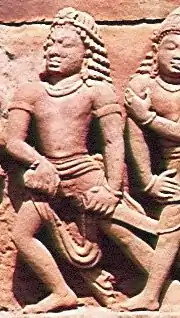Nandaka
Nandaka (literally "source of joy"[1]) or Nandaki is the sword of the Hindu god Vishnu. Even though some scriptures recommend the sword to be depicted in Vishnu's hand, it is generally not depicted in the iconography of Vishnu (who is generally depicted four-armed) and makes a later appearance in the god's sculptures. Nandaka is generally depicted in images where Vishnu is represented with more than four arms. The sword is compared to knowledge in Hindu scriptures.

The Vaishnav (Vishnu-worshipping sect) saints Annamacharya and Pey Azhwar are considered the avatars of Nandaka.
Iconography and development

Vishnu is usually depicted as four-armed with the four attributes in his hands: the shankha (conch), the Sudarshana chakra, the padma (lotus) and the Kaumodaki gada (mace). In eight or sixteen armed depictions of the deity, he may be shown holding a sword. The sword appears very rarely in the depictions of Vishnu. It appears in Vishnu iconography as late as the Gupta era (320–550 CE).
While Hindu scriptures narrate elaborate tales about how Vishnu gained his other weapons, none are told about the sword, apart from an allusion to the sword of Vishnu's avatar Rama in the Hindu epic Ramayana.[2] The Harivamsa as well as the Brahma Samhita prescribe the sword to be shown in Vishnu's four-armed images. The Sattvata Samhita recommends it to be shown in a right hand of a six-armed Vishnu and in a left-hand in a ten-armed Vishnu.[3] Vishnu' avatar Vamana is described to hold the Nandaka in his right hand in the Kalika Purana, but no such sculpture is found. An 11th-century image shows the sword tied to his belt.[4]
The Vishnu sahasranama, which enlists 1000 epithets of Vishnu, mentions Nandaka twice. In a mantra, Vishnu is praised as the holder of the shankha, Nandaka and chakra. The 994th name of Vishnu is "Nandaki", one who wields the Nandaka.[5]
In a rare depiction in the Sheshashayi Vishnu panel of the Gupta Deogarh temple, Nandaka is depicted anthropomorphically as a young man holding a sword (See Ayudhapurusha). He is depicted leading the other personified weapons of Vishnu against the demons Madhu and Kaitabha.[6][7] Nandaka is also depicted as an ayudhapurusha in the scene of Madhu and Kaitabha in the Mahishasuramardini mandapa, Mahabalipuram.
Symbolism
The Vishnu Purana says that Nandaka, "the pure sword" represents jnana (knowledge), which is created from vidya (translated variously as wisdom, knowledge, science, learning, scholarship, philosophy), its sheath is avidya (ignorance or illusion).[1] The Varaha Purana describes it as the destroyer of ignorance.[8]
The Krishna Upanishad as well as Swami Karpatri (1907–1982) in his Shri Vishnu Tattva equate the sword to the god. The former says that the Great God (Maheshvara, an epithet of Shiva) takes form of a flaming sword of knowledge, that destroys ignorance. Karpatri also associates Vishnu's sword with Akasha (ether). He says that Nandaka's sheath is darkness, who is also an aspect of God.[1]
Notes
- Alain Daniélou (1991). The Myths and Gods of India: The Classic Work on Hindu Polytheism from the Princeton Bollingen Series. Inner Traditions / Bear & Co. p. 160. ISBN 978-1-59477-733-2.
- Nanditha Krishna (July 2009). The Book of Vishnu. Penguin Books India. pp. 17, 24–5. ISBN 978-0-14-306762-7.
- Desai pp. 14-6
- Desai pp. 102-3
- Swami Chinmayananda. Vishnusahasranama. Chinmaya Mission. pp. 11, 246. ISBN 978-81-7597-245-2.
- C. Sivaramamurti, C. (1955). "The Weapons of Vishṇu". Artibus Asiae. Artibus Asiae publishers. 18 (2): 130. doi:10.2307/3248789. JSTOR 3248789.
- The Orissa Historical Research Journal. Superintendent, Research and Museum, Orissa. 1985. p. 88.
- V. R. Ramachandra Dikshitar (1999). War in Ancient India. Cosmo. pp. 146–7. ISBN 978-81-7020-894-5.
References
- Dr. Kalpana Desai (31 December 2013). Iconography of Visnu. Abhinav Publications. GGKEY:GSELHU3JH6D.
